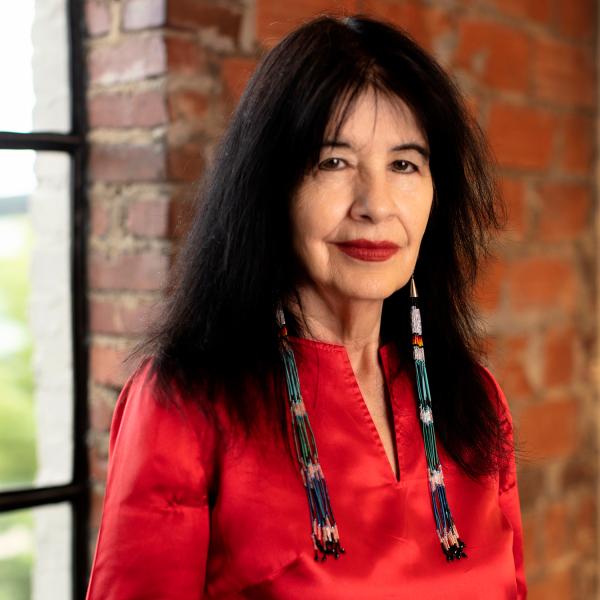Joy Harjo
National Humanities Medal
2022

—Makita Wilbur

—Makita Wilbur
The first time Joy Harjo saw her mother sing in public it was in grade school. She was exquisite, Harjo recalls, “in satin, frills, and perfume.” At first, she was “tentative, nervous,” but soon she came into her own, her voice resonant, transfixing. When her mother sang, her spirit “touch[ed] the sun.”
That élan runs through Harjo’s verse. A former U.S. poet laureate and the author of ten poetry collections, Harjo has a rhythmic sense, a feel for the melody in her writing. Some lines read like prayers. Consider the call in “Eagle Poem” to “open your whole self” to the world, “to sky, to earth, to sun, to moon.” Others are blessings, as in “The Creation Story,” when words “transfix us with love.” They are uniformly tender, attuned to beauty.
“I wanted to see everything,” she proclaims in her memoir Crazy Brave. Born in Tulsa, Oklahoma, in 1951, Harjo, a member of the Muscogee (Creek) Nation, communed with the sun in the early mornings. When her mother chatted with friends, Harjo was in the thick clover, playing with bees, inventing stories intricately plotted and delicately arranged.
Her prose is richly textured. She savors the red satin, black velvet, and sequined patterns of her mother’s clothes; she muses on the fish she catches with her grandfather, “glittering in the afternoon light.” Inflected in her vignettes is the luminosity of the Southwest, where Harjo studied in the 1960s and ‘70s, of piñon trees and “light filtered by mountains.” She is awake to the world in all of its brilliance. “I was born with eyes that can never close.”
What she saw was artwork flowering all around her. Among her favorites is an oil by her grandmother, Naomi Harjo, that hangs in her living room today. In it, the Seminole warrior Osceola, Harjo’s uncle by marriage, dazzles in a turban and ostrich feathers. He “refused to surrender to injustice,” Harjo writes, holding out the promise of a better world.
Rooted in her writing, in fact, is a kind of warrior spirit, a belief in the unwavering power of language. “Though we were young,” Harjo contends, “we had a sense of destiny.” As Native artists coming up in the late 1960s, Harjo and her peers yearned for a different future, one that would be expansive and fluid. Indeed, she asserts, “Our ancestors had imagined us with pride.”
Harjo drew with pride, too. For her, it was “dreaming on paper.” She loved the smell of crayons on newsprint. She hid in the closet and created worlds after her grandmother, awash in light. “My head was often in my sketchbook.”
Her academic path was circuitous. Harjo studied at the Institute of American Indian Arts in Santa Fe and, later, at the Iowa Writers’ Workshop, where she met the novelist Sandra Cisneros. In the foreword to the poetry collection Weaving Sundown in a Scarlet Light, Cisneros remembers her, long haired, cerebral. Harjo had driven across the country in a red pickup truck, two children in tow: “Her poems mapped my route home.”
Harjo didn’t take to Iowa. She was a self-described “sun lover,” and the workshop coincided with two of the century’s worst winters. Still, when asked what she learned there, Harjo has a poet’s finesse: “One morning as the sun struggled to break ice, and our dreams found us with coffee and pancakes in a truck stop along Highway 80, we found grace.”
Recurring in her prose are doorways. Some are closed on her, others open onto lush frontiers. When she was told as a child in church that having an active imagination was evil, she “closed the door.” When poetry found her, later in life, it was at “the doorway between panic and love.” To read Harjo is to step across that threshold, to arrive at a place unknown, and curiously, fantastically, familiar.
Harjo took the stage at the National Book Festival, in 2023. Her hair fell in long, dark tresses, her earrings in streams of beads and silver. She read from the poem “Remember,” her deep voice entrancing. For a moment, she was her mother, singing with abandon, touching the sun.
“We were wounded,” Harjo observes, “but it was in the wounding that we would find our strength.” Throughout her writing, Harjo crystallizes what is vaporous, bringing to light all that is hidden. To write with that lucidity is “an act of affirmation, even of sovereignty.” In the end, that is the task of the artist, to open the door, to “help the next person find their way through the dark.”
—Angelica Aboulhosn